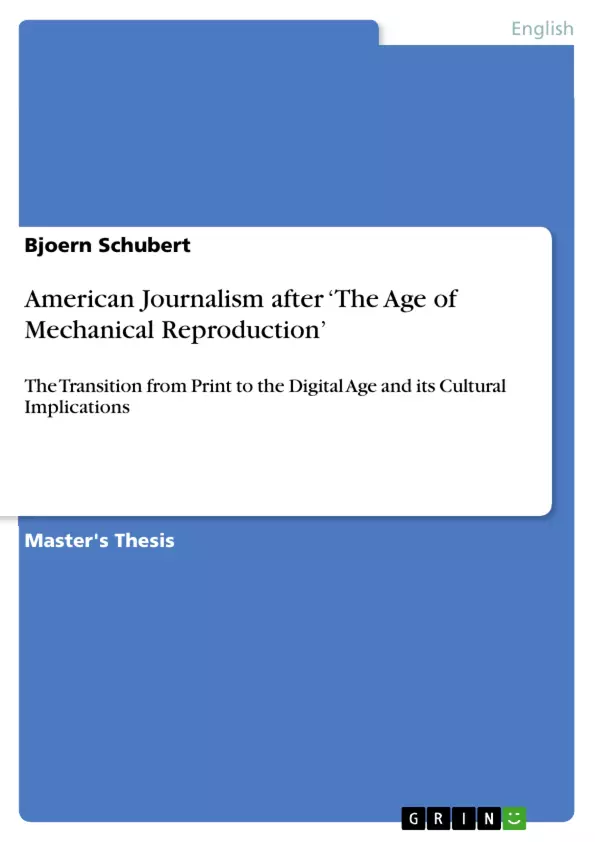In a 2009 report, titled “The Resurrection of American Journalism”, Leonard
Downie Jr., former executive editor of the Washington Post, and Michael Schudson,
professor of journalism point out: “American journalism is at a transformational
moment in history.” (1) They both argue that the era of dominant print journalism
in the United States of America is ending and rapidly giving way to digital
journalism. A range of major regional American newspapers such as the Seattle
PostIntelligencer
in 2009, for example, have gone out of business in recent years.
Even nationwide institutionalized newspapers such as the New York Times are not
exempt from this overall development.
In the digital age there will be a steady rise, not a decline in the general
demand for news – yet the quality, the long established business models, and the
distribution of media are drastically changing at this point. Jeff Jarvis articulated the
most severe change that is currently happening recently in his blog Buzzmachine, in
which he outlines the revolutionary transition from a print to a Link Economy:
Those old companies still operate in the content economy, begun 570 years by Gutenberg, in
which the owner of content profited by selling multiple copies. Online, there needs to be only
one copy of content and it is the links to it that bring it value. Content without links has no
value. So when search engines, aggregators, bloggers, and Twitterers link to content, they
are not stealing; they are giving the gift of attention and audience. Indeed, publishers should
be grateful that Google does not charge them for the value of its links.6
In this thesis I will follow Jarvis’ line of argumentation that the nature of journalism
will change in the Link Economy in many ways, thereby opening a wide range of
discussions among scholars from many different fields.
Inhaltsverzeichnis (Table of Contents)
- Introduction
- Decisive Moments and Constitutive Coordinates in the History of American Journalism
- The Production of News
- The Distribution of News
- The Reception of News
- The Function of Print Journalism for the Creation of Public Spheres and Communities
- Thomas Jefferson: A Noble Experiment
- Alexis de Tocqueville on The Relation Between Public Associations and the Newspapers
- Jürgen Habermas: The Public Sphere
- Benedict Anderson: Imagined Communities
- Major Shifts in American Journalism from First to Second Media Age
- The Role of the Hyperlink and the Search Engine in the Second Media Age
- Marshall McLuhan's Visions of the Global Village
- The Temporal Dimensions of Digital News
- Locality and Spatial Dimensions of Digital News
- The Reader's Desire to be a Writer and Editor of Digital News
- Transatlantic Reconfigurations of (Print) Journalism in the Digital Age
- A Case Study of the Berlin-based personalized newspaper niiu
- A Case Study of German newspaper WELT KOMPAKT - 'Scroll Down Edition'
- The New York Times 'Insight Lab'
Zielsetzung und Themenschwerpunkte (Objectives and Key Themes)
This thesis analyzes the transition of American journalism from the era of print media to the digital age, examining the cultural implications of this transformation. It explores the impact of the digital environment on the production, distribution, and reception of news, investigating how the rise of the hyperlink and search engines has reshaped the traditional journalistic landscape. The work also delves into the evolving role of journalism in fostering public spheres and imagined communities in the digital age.
- The shift from print to digital journalism in the United States
- The influence of the internet and new technologies on the production and consumption of news
- The impact of the Link Economy on the economic viability and future of journalism
- The role of journalism in shaping public spheres and imagined communities in both print and digital contexts
- The cultural implications of the transition from print to digital media
Zusammenfassung der Kapitel (Chapter Summaries)
The introduction of the thesis establishes the context for the subsequent analysis, outlining the historical trajectory of American journalism and the current transformation it is undergoing. It highlights the decline of traditional print media and the rise of digital platforms as dominant forces in the news landscape.
The first chapter delves into the historical development of American journalism, examining the key moments and defining characteristics of its evolution. It explores the production, distribution, and reception of news in different eras, emphasizing the crucial role of print media in shaping public spheres and fostering community identity.
The second chapter examines the theoretical frameworks that inform our understanding of public spheres and imagined communities, focusing on the work of scholars like Thomas Jefferson, Alexis de Tocqueville, Jürgen Habermas, and Benedict Anderson.
Chapter 3 examines the major shifts that have occurred in American journalism as it transitioned from the first to the second media age. It explores the impact of the hyperlink and search engines on the production and distribution of news, as well as the implications of these changes for the temporal and spatial dimensions of journalistic content.
The fourth chapter presents case studies of transatlantic reconfigurations of print journalism in the digital age. It examines the approaches of different publications, such as the Berlin-based niiu, the German newspaper WELT KOMPAKT, and The New York Times, highlighting how these organizations are adapting to the evolving media landscape.
Schlüsselwörter (Keywords)
This thesis focuses on the transformation of American journalism from print to digital media. Key themes include the digital divide, the Link Economy, the role of journalism in democratic societies, the evolution of public spheres and imagined communities in the digital age, the impact of new technologies on the production and consumption of news, and the cultural implications of the transition from print to digital media.
- Arbeit zitieren
- Bjoern Schubert (Autor:in), 2010, American Journalism after ‘The Age of Mechanical Reproduction’, München, GRIN Verlag, https://www.grin.com/document/175196



